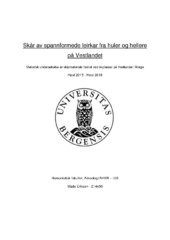| dc.contributor.author | Eriksen, Mads | |
| dc.date.accessioned | 2016-12-27T08:33:11Z | |
| dc.date.available | 2016-12-27T08:33:11Z | |
| dc.date.issued | 2016-11-21 | |
| dc.date.submitted | 2016-11-21 | eng |
| dc.identifier.uri | https://hdl.handle.net/1956/15266 | |
| dc.description.abstract | Rundt år 375 AD et sted på Vestlandet i Norge, sannsynligvis Jæren i Rogaland fylke, starter en pottemakertradisjon like plutselig som den forsvinner. Bare 175 år senere, rundt 550 AD, mister vi sporet etter denne unike tradisjonen. I ettertid får denne keramikken flere navn som urtepotter, stenkar og senere spannformede leirkar. I denne oppgaven vil betegnelsen spannformede leirkar bli benyttet. Spannformede leirkar opptrer i funnmaterialet i all hovedsak på Vestlandet i fylkene Rogaland, Hordaland, Sogn og Fjordane og Sogn og Fjordane. Ellers finnes de i hele Norge, helt opp til sør i Troms fylke, men i betydelig mindre antall. Spannformede leirkar har vært brukt til både matlaging og som gravgods. Man finner dem følgelig i graver, åpne boplasser, nausttufter og på boplasser i huler og hellere. Denne oppgaven skal fokusere på boplassmaterialet, noe som ikke er gjort tidligere. For å avgrense oppgavens omfang og størrelse, blir boplasser begrenset til huler og hellere på Vestlandet. Det inkluderes også to åpne boplasser for å danne ett sammenligningsgrunnlag mellom forskjellige typer boplasser. Først var det nødvendig å klassifisere alle skårene. Dette ble gjort ved å anvende en metode utviklet for hele kar, av Asbjørn Engevik jr. Metoden viste seg å være anvendbar på ett lite utvalg av skårmaterialer, nærmere bestemt 10,5%. Dette muliggjorde en rekke sammenligninger med allerede etablert forskning, utført på hele kar funnet i graver. Sammenligningene viser at det er ingen betydelig forskjell på skår funnet i huler og hellere, åpne boplasser eller graver. Med dette til grunn, gjøres det også en analyse for hva dette har å si for bruken av huler og hellere og samfunnet generelt. | en_US |
| dc.description.abstract | This paper is a master's thesis in archaeology, written by Mads Eriksen for the University in Bergen. The theme of this paper is sherds of bucket-shaped pots found in caves and rock shelters in western Norway. This paper aims to classify and compare shards of bucket-shaped pots, using methods established for whole pots. The tradition of making bucket-shaped pots arises around the year 375 AD and ends at about 550 AD. This period will work as the chronological framework for this paper. The geographical framework is the western part of Norway mainly the counties Rogaland, Hordaland. Møre og Romsdal and Sogn og Fjordane. The method for classifying the sherds were so chosen because of the underlying objectivity of the method. The method incorporates what tools were used to make the decorations on the pots/sherds. After classifying all the sherds, the aim was to compare them to the results from the analysis of the whole pots. An important aspect to note, is that almost all of the whole pots are found in graves. What became immediately clear, was that classifying small sherds was quite difficult. The small size of the sherds meant that there was not much decoration visible. This meant that a lot of the classifications defaulted to a general group of classification. There were however some shards that were possible to classify accurately and surely. The sherds that were in fact possible to classify was compared to the grave material in regards to, distribution in time, tempering material and geographical distribution. I also made an attempt to analyze the quality of the sherds, also using objective parameters. In addition to caves and rock shelters, there were sherds from two open dwellings, or farms included in the study. The latter part of the paper focuses on the societal implications, should the classification and comparison be a success. What was found was that there were almost no differences in the material that could be analyzed in a proper way. Meaning that it seemed to make no difference whether the sherds were found in caves and rock shelters or open dwellings. Also with regards to the grave material, no actual differences were found. The conclusion was thereafter that, even if the shards of the bucket-shaped pots could not tell exactly what or who used the rock shelters, it had to be a strong connection. The method for classification used proved useful, if not also a bit unrefined for sherds, which was to be expected. | en_US |
| dc.format.extent | 3314120 bytes | eng |
| dc.format.mimetype | application/pdf | eng |
| dc.language.iso | nob | eng |
| dc.publisher | The University of Bergen | eng |
| dc.subject | Spannformede leirkar | eng |
| dc.subject | Skår | eng |
| dc.subject | Hellere | eng |
| dc.subject | Vestlandet | eng |
| dc.subject | Folkevandringstid | eng |
| dc.subject | Jernalder | eng |
| dc.subject | Romertid | eng |
| dc.title | Skår av spannformede leirkar fra huler og hellere på Vestlandet. Metodisk undersøkelse av skårmateriale funnet ved boplasser på Vestlandet i Norge | eng |
| dc.type | Master thesis | |
| dc.rights.holder | Copyright the author. All rights reserved | eng |
| dc.description.degree | Master i Arkeologi | |
| dc.description.localcode | MAHF-ARK | |
| dc.description.localcode | ARK350 | |
| dc.subject.nus | 713306 | eng |
| fs.subjectcode | ARK350 | |
